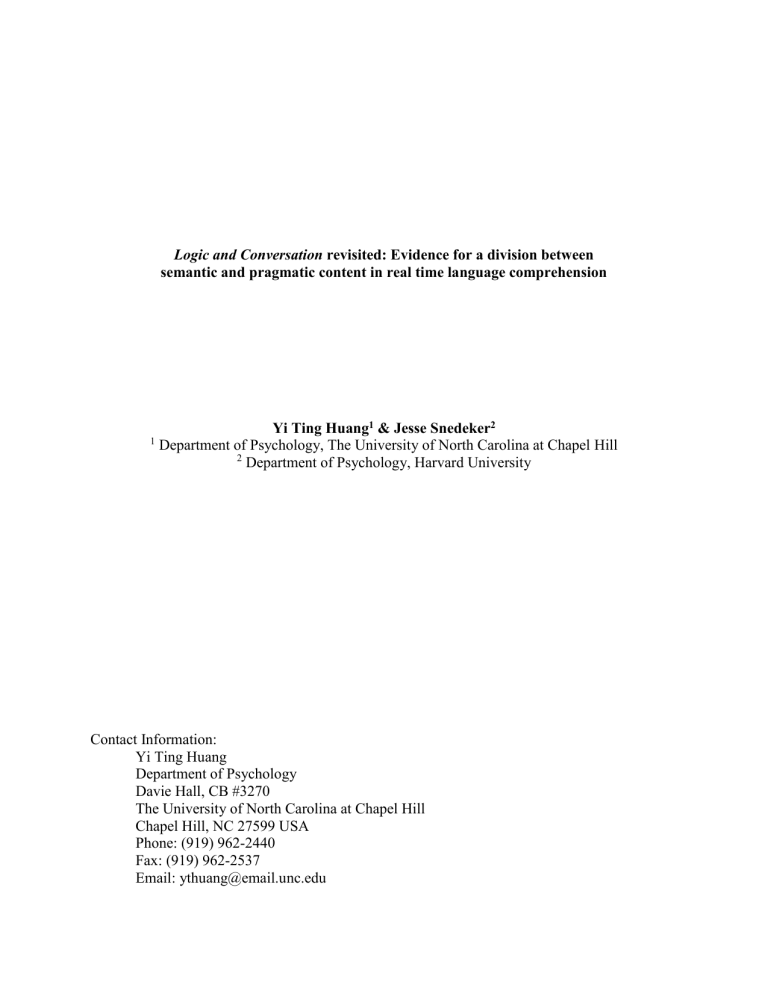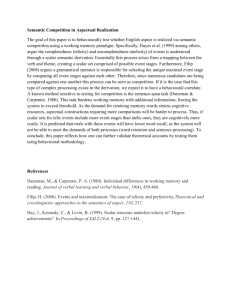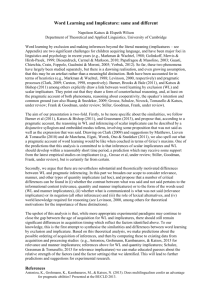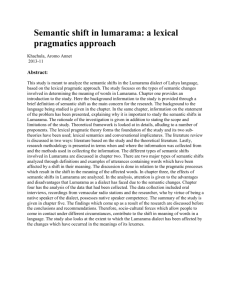Snedeker_LogicConversation

Semantics-pragmatics interface 0
Logic and Conversation revisited:
Evidence for a division between semantic and pragmatic content in real time language comprehension
1
Yi Ting Huang 1 & Jesse Snedeker 2
Department of Psychology, The University of North Carolina at Chapel Hill
2 Department of Psychology, Harvard University
Contact Information:
Yi Ting Huang
Department of Psychology
Davie Hall, CB #3270
The University of North Carolina at Chapel Hill
Chapel Hill, NC 27599 USA
Phone: (919) 962-2440
Fax: (919) 962-2537
Email: ythuang@email.unc.edu
0
Semantics-pragmatics interface 1
Acknowledgments
This paper is based upon work supported by the National Science Foundation under Grant
No. 0623845. We would like to thank Silvia Chen for her help in data collection.
1
Semantics-pragmatics interface 2
Abstract
The distinction between semantics (linguistically-encoded meaning) and pragmatics
(inferences about communicative intentions) can often be unclear and counter-intuitive. For example, linguistic theories argue that the meaning of some encompasses the meaning of all while the intuition that some implies not all results from an inference. We explored how online interpretation of some evolves using an eye-tracking while listening paradigm. Early eyemovements indicated that while some was initially interpreted as compatible with all , participants began excluding referents compatible with all approximately 800ms later.
These results contrast with recent evidence of immediate inferencing and highlight the presence of bottom-up semantic-pragmatic interactions which necessarily rely on initial access to lexical meanings to trigger inferences.
Keywords: semantics, pragmatics, scalar implicature, quantifiers
2
Semantics-pragmatics interface 3
Imagine overhearing the following conversation:
(1) Mother: Did you finish the ice cream sandwiches?
Child: I ate some of them.
Now suppose that you know that the child had in fact polished off the frozen novelties. Did she lie? Logicians would be inclined to say no – the child’s statement is logically consistent with the fact that she ate all of the ice cream sandwiches. Ask the mother, however, and she would most likely disagree – if the child says she ate some of them, she is indicating that she didn’t eat all of them. Who is correct in this situation?
The philosopher Paul Grice (1975) would have said that both of them are. He argued for a division between interpretations that emerge from the meanings of words ( semantics ) and those that depend on inferential analysis of the speaker’s communicative goals ( pragmatics ). This distinction sheds light on why terms like some have two different interpretations (Horn, 1989;
Gadzar, 1979). The logician’s answer depends on the semantics of the quantifier whose referents include the stronger term on the same scale ( some and possibly all ). In contrast, the likely interpretation from the mother’s point of view incorporates a pragmatic inference called a scalar implicature which imposes an additional upper-boundary that excludes referents compatible with the maximal term ( some but not all ). This interpretation is motivated by the expectation that if the child had eaten all of the frozen novelties, she would have simply said so, but since she did not, she must have eaten only a subset of them.
Scalar implicatures are both frequent and robust in everyday speech, thus it might seem unlikely that listeners would ever entertain the less common and less precise semantic meaning.
Considerations such as these have led some to posit that these inferences are stored in the lexicon
3
Semantics-pragmatics interface 4
(Levinson, 2000) or generated directly by the grammar (Chierchia, 2004). This view is also consistent with empirical findings demonstrating listeners’ rapid use of contextual cues to infer the speaker’s intent (Sedivy, Tanenhaus, Chambers, & Carlson, 1999). Evidence of this kind has been so persuasive that it has become increasingly implausible that any well-practiced process would show measurable delays (
Tanenhaus, Spivey-Knowlton, Eberhard, & Sedivy,
1995;
Altmann & Kamide, 2004).
Recent data however suggest that scalar implicature may involve a slower, more effortful process
(Noveck & Posada, 2003; De Neys & Schaeken, 2007)
.
Bott and Noveck (2004) compared the response times for truth-value judgments of sentences like “Some elephants are mammals” and found that participants who spontaneously generated the implicature (judged the statement to be false) took longer than those who interpreted the statement according to its semantic meaning (judged it to be true). Huang and Snedeker (2009a) explored the nature of this temporal delay by presenting participants with instructions like
“Point to the girl that has some of the socks” and monitoring their eye-movements to displays featuring a girl with 2 of 4 socks and another with 3 of 3 soccer balls. This procedure features a critical period of ambiguity at the onset of the quantifier where the semantics of some is compatible with both characters. This ambiguity could be immediately resolved by calculating a scalar implicature to restrict interpretation to the girl with the subset of items. Instead, participants’ reference resolution following some was substantially delayed, suggesting a temporal lag between semantic processing and the calculation of the pragmatic inference.
Nevertheless, the presence of a delay in calculating the scalar implicature meant that this study failed to find clear evidence that participants ever calculated the inference online, raising questions about the sensitivity of the task. Furthermore, more recent studies adopting a similar
4
Semantics-pragmatics interface 5 paradigm have failed to find temporal discrepancies between semantic and pragmatic processing
(Grodner, Klein, Carbary, & Tanenhaus, in press; Breheny, 2009). Thus this present study borrows the methods established by Huang and Snedeker (2009a) but seeks evidence for the hypothesized switch from a bare semantic analysis to a pragmatically-enriched one. By contrasting pairs of compound nouns as potential referents (e.g., ice cream sandwiches vs. ice cream cones ), we can extend the period of semantic ambiguity and ascertain when scalar implicatures occurs.
Methods
Twenty English-speaking undergraduates sat before an inclined podium with shelves in each quadrant and a camera at the center to record their direction of gaze. On every trial, the experimenter acted out a story in which two sets of items were divided among four characters.
These stories were followed by auditory instructions like (2).
(2) Point to the girl that has some/two/all/three of the ice cream sandwiches.
The number trials served as controls to ensure that any delay in reference resolution for some compared to all could not be attributed to a preference to look at larger sets. Since these terms do not require a pragmatic inference to restrict reference, they do not generate the same temporary ambiguity as some .
The visual displays featured characters arranged so that the vertically-adjacent characters matched in gender while the horizontally-adjacent characters did not (Figure 1). For some and all trials, one set of four items was split between a horizontally-adjacent pair (boy-with-2 vs. girl-with-2) and another set of three items was given to one of the remaining children (boy-with-
0 vs. girl-with-3).
For two and three trials, the first set was again evenly split between one boygirl pair while the second set now included four items which were split unevenly between a
5
Semantics-pragmatics interface 6
(A) second pair (boy-with-1 vs. girl-with-3).
This difference between the number and quantifier trials was necessary to ensure that the partitive construction was felicitous for all trial types but it did not change the visual properties of the potential Targets.
(B)
(C) (D)
Figure 1: Examples of visual-world displays for (A) some , (B) two , (C) all , and (D) three trials.
Participants here were instructed to “Point to the girl that has ____ of the ice cream sandwiches.”
The girl with ice cream sandwiches was the Target while the girl with ice cream cones was the
Distractor.
The critical utterances differed only in the gender of the child that was requested and the identity of the final word. The character who was requested was called the Target (girl-with-icecream-sandwiches) while the one who matched in gender but had a different item was called the
6
Semantics-pragmatics interface 7
Distractor (girl-with-ice-cream-cones). The names of the two items were always compound nouns that shared the same two-syllable onset. Each of the 16 items was rotated through the four quantifier conditions across four presentation lists such that each list contained four items in each condition and each item appeared once in every list.
To determine the earliest point in the utterance at which the Target could logically be indentified (assuming no processing delays)
, we conducted two separate off-line gated-listening tasks with additional groups of participants. To establish the length of period of ambiguity between the compound noun pairs, w e presented 16 participants with 100ms incremental segments of the audio instructions
(Tyler & Wessels, 1983)
. After each segment, they were asked to indicate whether they heard the Target or Distractor word.
Participants correctly disambiguated the utterance at above chance levels 1400ms after quantifier onset (M=77%; all p’s<.01).
This extended window also allows us to more rigorously test accounts favoring early scalar implicatures by mapping the time-course of on-line processing onto the phonological markers associated with inferencing in an off-line task. To determine how much phonological information is necessary to derive a scalar implicature, we presented 20 participants with the relevant stories/displays and phrasal increments of the critical utterance (“Point-to-the-girl-thathas-some/two/all/three | of-the | ice-cream | sandwiches”). Each of the 16 items was rotated through the four continuation conditions across four presentation lists such that each list contained four items in each condition and each item appeared once in every list.
After each segment, they
were asked to select the character that corresponded to what they had heard and saw. Selections of the Target were above chance in the first segment across all quantifiers
(M=91%; all p’s<.05), indicating that our materials were successful in establishing expectations
7
Semantics-pragmatics interface 8 that (1) quantifiers would refer specifically to the sets in the display, (2) objects would be identified by basic-level labels, and (3) some would be interpreted with a scalar implicature.
Our critical question concerns the timing of semantic and pragmatic processing during realtime comprehension. If scalar implicatures are immediately calculated following the onset of the quantifier, we should expect reference restriction via the inference to be time-locked to this moment. If instead the inference is preceded by prior semantic analysis of the quantified expression, then we might expect delays in looks to the referent to persist beyond this point.
Results
Eye movements were coded by noting each change in gaze direction towards one of the quadrants or the center (Snedeker & Trueswell, 2004). Twenty-five percent of the trials were checked by second coder who confirmed the direction of fixation for 95% of the frames. Our dependent measure was looking time to the Target as a proportion of looking time to the Target and Distractor. Looks to the other characters accounted for less than 5% of fixations after onset of the gender cue. Each time window was analyzed with ANOVAs with quantifier Scale
(number vs. scalar) and Strength (lesser vs. greater) as within-subject and item variables and list/item group as a between-subjects and items variable.
We first examined fixations from the onset of the gender cue to the onset of the quantifier
(“girl that has”) to compare baseline looks to the Target and Distractor before the influence of the quantifier. During this period, Target looks remained around chance for all terms, leading to no reliable effects of Scale or Strength (all p’s>.15). We then examined Target fixations for
100ms intervals beginning from the onset of the quantifier to the point where the compound noun was phonologically disambiguated (Figure 2). For the some trials, this defined a 1400ms period of semantic ambiguity. Each time window is labeled by its onset relative to the quantifier.
8
Semantics-pragmatics interface 9
Figure 2: The time-course of looks to target for the four trial types
We found that Target fixations in the three trials rose above chance during the initial
200ms time window (67%; t1(19)=3.45,p<.01; t2(15)=3.71,p<.01
) while those in the two (63%; t1(19)=2.87,p<.05; t2(15)=3.45,p<.01
) and all trials (66%; t1(19)=3.13,p<.01; t2(15)=4.75,p<.
01
) quickly followed in the 300ms window. Since saccadic eye-movements take up to 200ms to be programmed after the relevant marker in the speech stream (Matin, Shao & Boff, 1993), these results indicate that the semantics of these terms was used to restrict reference at the earliest moments of language processing. In contrast, Target looks for the some trials did not reliably exceed chance until the 1100ms window (63%; t1
(19)=2.13,p<.05; t2(15)=1.88,p<.10
).
1
Participants initially looked equally at both characters, suggesting that the scalar implicature was not available to rule out the Distractor during this early period of processing. The difference in
1 Due to the relatively small number of items used, some effects that were robust in the subjects analysis failed to reach conventional levels of significance in the items analysis.
9
Semantics-pragmatics interface 10
Target fixations across these four terms led to a significant Scale by Strength interaction from the
400ms ( F1(1,16)=5.06,p<.05; F2(1,15)=8.47,p<.05
) through the 1100ms window ( F1(1,16)=
5.39,p<.05; F2(1,15)=4.16,p<.10
).
To determine when the scalar implicature reliably occurred, we conducted a second analysis examining the saccades that occurred during each time window, rather than the fixations. This allows us to isolate the point at which new eye-movements to the Target outnumber those to the Distractor. We separated the trials based on the object that the participant was initially fixating on in the previous frame of a critical 200ms time window (the Target or
Distractor) and calculated the probability of switching to the other object during that period
(Table 1).
Some
Two
All
Three
… has
Time from the onset of the quantifier some/two/all/three of the ice ...
-200ms
8% vs. 15%; t1(19)=0.85, p>.40; t2(15)=0.20, p>.80
16% vs.
14%; t1(19)=0.28, p>.70; t2(15)=0.31, p>.70
0ms
5% vs. 17% ; t1(19)=2.21, p<.05; t2(15)=1.36, p>.15
14% vs. 8%; t1(19)=0.85, p>.40; t2(15)=1.10, p>.30
200ms
9% vs. 21%; t1(19)=1.60, p<.10; t2(15)=2.93, p<.05
22% vs. 3% ; t1(19)=2.68, p<.05; t2(15)=2.29, p<.05
400ms
12% vs. 13%; t1(19)=0.17, p>.90; t2(15)=0.42, p>.60
24% vs. 3% ; t1(19)=3.48, p<.01; t2(15)=2.33, p<.05
600ms
7% vs. 6%; t1(19)=0.23, p>.80; t2(15)=0.62, p>.60
N/A
800ms
17% vs. 1% ; t1(19)=2.59, p<.05; t2(15)=2.18, p<.05
N/A
24% vs. 9% ; t1(19)=2.22, p<.05; t2(15)=3.00, p<.01
4% vs. 9%; t1(19)=1.44, p>.15; t2(15)=2.11, p<.10
11% vs. 7%; t1(19)=0.77, p>.40; t2(15)=0.11, p>.90
7% vs. 11%; t1(19)=0.68, p>.50; t2(15)=0.64, p>.50
13% vs. 8%; t1(19)=1.27,p
>.20; t2(15)=1.43, p>.15
32% vs.
11% ; t1(19)=2.51, p<.05; t2(15)=3.34, p<.01
27% vs. 2% ; t1(19)=4.02, p<.01; t2(15)=3.99, p<.01
25% vs.
12% ; t1(19)=2.54, p<.05; t2(15)=2.15, p<.05
N/A
N/A
N/A
N/A
N/A
Table 1: The percentage of switches to the Target as opposed to the percentage of switches off
1000ms
N/A
N/A
N/A
10
Semantics-pragmatics interface 11 the Target are listed for each 200ms time window along with the approximate corresponding word in the instruction. Subjects and items t-tests comparing the two percentages and significant differences between these switches are marked in bold. These switches were not calculated once participants’ initial looks to the Target reached a ceiling of 70 percent.
We found that at the onset of the quantifier, there was a Distractor preference in the shifts for the some trials
, suggesting that participants had a visual preference for the total set prior to calculating the implicature.
2
In the following 200ms time window, we found a robust Target preference in shifts for two , all , and three but not for some . This led to a significant Scale by
Strength by Initial-fixation interaction from the 200ms (
F1(1,16)=5.04,p<.05; F2(1,15)=7.33, p<.05
) through the 600ms window (
F1(1,16)=5.00,p<.05; F2(1,15)=4.24,p<.10
). Critically in the 800ms window, participants in the some trials were more likely to switch to the Target on the
Distractor-initial trials than they were to switch to the Distractor on Target-initial trials
. This time window roughly corresponds to the onset of the final noun and indicates that a Target preference emerged well after the onset of the phonological cues necessary for the scalar implicature. These results suggest the presence of an extended period semantic analysis which proceeds the generation of this inference.
3
Discussion
2
We believe that this pattern largely reflects differences in visual saliency across the different displays. In the some trials, participants preferred to look at the character that has the unique item (the Distractor) over one that has the shared item (the Target) prior to the onset of the quantifier. Qualitative patterns of this sort are also seen in prior studies with both adults (Huang
& Snedeker, 2009a; Grodner et al., in press) and children (Huang & Snedeker, 2009b).
Critically, this preference was short-lived and disappeared following the onset of the quantifier,
3 suggesting that they reflect perusal of the display prior to an informative linguistic cue.
Further evidence that this delay reflects initial semantic analysis of some comes from
Experiment 3 in Huang and Snedeker (2009a). Participants were able to immediately disambiguate the Target after quantifier onset when a scalar implicature was not necessary for reference restriction, i.e., when the subset was contrasted with an empty set (girl-with-none-ofthe-socks). This suggests that this current delay can be attributed to the initial unavailability of a necessary implicature for ruling on the total set.
11
Semantics-pragmatics interface 12
This study provides evidence of the dynamic interplay between semantic and pragmatic processes during real-time comprehension. We found that when lexical semantics is sufficient to identity a referent, disambiguation of the utterance is quite rapid. However, when a pragmatic inference is required, reference resolution is substantially delayed. Listeners initially access the semantic meaning of some but fail to calculate the pragmatic inference until about 800ms after the requisite phonological input.
The pattern
is rather remarkable given the preference for the scalar implicature in everyday communication and its robustness in our task.
These findings bear on current debates in the theoretical literature on the nature of pragmatic inferences and their relation to semantic representations (Noveck & Sperber, 2007).
Among the variety of post-Gricean pragmatic theories that have been developed, in one category are explanations favoring immediate scalar implicatures. These include Neo-Gricean accounts suggesting that habitual application of these inferences causes the implicated meaning to be stored in the lexicon (Levinson, 2000) and more recent psycholinguistic accounts suggesting that some is polysemous between semantic and pragmatic interpretations (Degen, Reeder, Carbary, &
Tanenhaus, 2009). In another category are accounts that leave open the possibility of a delay between phonological input and pragmatic inference. Prominent among these is Relevance theory which proposes that all inferences, including implicatures, are guided by a more general tradeoff between the possible gains associated with generating an inference and the amount of cognitive effort necessary to derive it (Sperber & Wilson, 1986/1995).
Our data present a particular challenge to the automatic processes invoked by proposals of the first kind. If scalar implicatures were lexicalized, then we would expect them to emerge as rapidly as semantic content. Yet we found a delay of 600ms between the use of the lexicallyencoded upper-bound of two and the pragmatically inferred upper-bound of some . Alternatively,
12
Semantics-pragmatics interface 13 it may be the case that the two readings of some are polysemous and that both meanings are initially activated but after a short delay only the contextually appropriate one persists (Swinney,
1979; Tanenhaus, Leiman, & Seidenberg, 1979). However, if the relative influence of each meaning was proportional to its frequency or contextual fit, then preference for the Target would still be more robust that for the Distractor since the subset is generally preferred in communication and was overwhelmingly preferred in our off-line task (see Methods). Instead we found no evidence of a reliable Target preference during the first 800ms of the ambiguous region, suggesting that only the semantic meaning was initially available.
The presence of an on-line scalar implicature imposes constraints on the more open-ended processes invoked by Relevance theory (Carston, 1998). One possibility is that the mechanisms that generate interpretations only retrieved the semantic meaning of some since an implicature was not relevant in a task where referents were lexically disambiguated by the end of the sentence
. Another possibility is that the listener automatically generated the inferred interpretation first since it is the more typical interpretation of the term.
Yet neither of these alternatives neatly captures the initial delay between semantic activation and inferential processes found in our data. To account for this pattern, the Relevance theory would need to predict that initial activation of the lower-bounded interpretation does not meet an internal standard of relevance which motivates subsequent generation of the implicature.
Finally, how can we reconcile these results with evidence demonstrating that pragmatic processing influences interpretation early in comprehension (Tanenhaus et al., 1995;
Altmann &
Kamide, 2004
)? Clearly a complete synthesis awaits more data. In the meantime, we simply note the utility of distinguishing between two types of semantic-pragmatic interactions: (1) Cases in which pragmatic constraints are in place before a particular word is uttered, influencing how
13
Semantics-pragmatics interface 14 this word is understood and incorporated into the analysis; (2) Cases in which the meaning of a given word is critical for triggering the pragmatic inference. Many examples of the rapid pragmatic effects are phenomena of the first kind and are compatible with standard models of language processing in which pre-existing top-down constraints shape the perception and interpretation of lower levels of linguistic analysis (Trueswell & Tanenhaus, 1994; Altmann,
2001).
In contrast, our study focuses on an important example of the second kind. Under most linguistic analyses a scalar implicature arises because of the meaning of the scalar term.
Consequently, it is unsurprising that access to this meaning must precede the calculation of the inference. These results elucidate the nature of semantic and pragmatic interpretation by highlighting the relationship between these processes during real-time comprehension. They extend Grice’s (1975) distinction between meaning and inference by demonstrating that the information provided by these distinct levels of interpretation becomes available at different moments during comprehension. In other words, some can be all and it cannot be all but just not at the same time.
14
Semantics-pragmatics interface 15
References
Altmann, G. M. (2001). The language machine: Psycholinguistics in review. British Journal of
Psychology , 92, 129-170
Altmann, G. M.
, & Kamide, Y. (2004). Now you see it, now you don't: mediating the mapping between language and the visual world. In J. Henderson and F. Ferreira (eds.) The integration of language, vision and action . pp. 347-386. Psychology Press.
Bott, L. & Noveck, I. A. (2004). Some utterances are underinformative: The onset and time course of scalar inferences. Journal of Memory and Language . 51(3), 437-457.
Breheny, R. (2009). How pragmatic reasoning affects incremental utterance interpretation.
Paper presented at the 2009 Experimental Pragmatics Conference . Lyon, France.
Carston, R. (1998).
Informativeness, relevance and scalar implicature. In R. Carston and S.
Uchida (eds.) Relevance Theory: Applications and implications . pp. 179-236. Amsterdam:
John Benjamins.
Chierchia, G. (2004). Scalar implicatures, polarity phenomena, and the syntax/pragmatics interface. In A. Belletti (ed.), Belletti structures and beyond . Oxford: Oxford University
Press.
Degen, J., Reeder, P., Carbary, K., & Tanenhaus, M. (2009). Using a novel experimental paradigm to investigate the processing of scalar implicatures. Paper presented at the 2009
Experimental Pragmatics Conference . Lyon, France.
De Neys, W., & Schaeken, W. (2007). When people are more logical under cognitive load: Dual task impact on scalar implicature. Experimental Psychology , 54, 128-133.
Gadzar, G. (1979). Pragmatics: Implicature, presupposition and logical form . New York:
Academic Press.
15
Semantics-pragmatics interface 16
Grice, H. P. (1975). Logic and conversation. In: Cole, P. & Morgan, J. L., (eds.), Syntax and
Semantics, vol. 3: Speech Acts , pp. 41-58. New York: Academic Press.
Grodner, D., Klein, N., Carbary, K., & Tanenhaus, M. (in press). Experimental evidence for rapid interpretation of pragmatic ‘some.’ To appear in Cognition .
Horn, L. (1989). A natural history of negation . Chicago, IL: University of Chicago Press.
Huang, Y. & Snedeker, J. (2009a). On-line interpretation of scalar quantifiers: Insight into the semantics-pragmatics interface. Cognitive Psychology , 58, 376-415.
Huang, Y., & Snedeker, J. (2009b). Semantic meaning and pragmatic interpretation in five-year olds: Evidence from real time spoken language comprehension. Developmental Psychology ,
45(6), 1723-1739.
Levinson, S. (2000). Presumptive meanings . Cambridge, MA: MIT Press.
Matin, E., Shao, K.C. & Boff, K.R. (1993) Saccadic overhead: information processing time with and without saccades. Perception & Psychophysics , 53(4), 372-380.
Noveck, I. A. & Posada, A. (2003). Characterizing the time course of an implicature: An evoked potentials study. Brain and Language, 85, 203-210.
Noveck, I. A. & Sperber, D. (2007). The why and how of experimental pragmatics: The case of
‘scalar inferences’. In N. Burton-Roberts (Ed.) Advances in Pragmatics . Basingstoke:
Palgrave.
Sedivy, J., Tanenhaus, M., Chambers, C., & Carlson, G. (1999). Achieving incremental semantic interpretations through contextual representation. Cognition , 71, 109-147.
Snedeker, J. & Trueswell, J. C. (2004). The developing constraints on parsing decisions: The role of lexical-biases and referential scenes in child and adult sentence processing. Cognitive
Psychology , 49, 238-299.
16
Semantics-pragmatics interface 17
Sperber, D. & Wilson, D. (1986/1995). Relevance: Communication and Cognition . Oxford:
Blackwell.
Swinney, D. (1979). Lexical access during sentence comprehension: (Re)consideration of context effects. Journal of Verbal Learning and Verbal Behavior , 18, 645-660.
Tanenhaus, M., Leiman, J., & Seidenberg, M. (1979). Evidence for multiple stages in the processing of ambiguous words in syntactic contexts.
Journal of Verbal Learning and
Verbal Behavior , 18, 427-440.
Tanenhaus, M. K., Spivey-Knowlton, M., Eberhard, K., & Sedivy, J. (1995). Integration of visual and linguistic information in spoken language comprehension. Science , 268, 1632.
Trueswell, J. & Tanenhaus, M. (1994). Toward a lexicalist framework of constraint-based syntactic ambiguity resolution. In C. Clifton and L. Frazier (eds.), Perspectives on sentence processing . Hillsdale, NJ: Lawrence Erlbaum.
Tyler, L.K. and Wessels, J. (1983). Quantifying contextual contributions to word recognition processes. Perception & Psychophysics , 34, 409-420.
17





